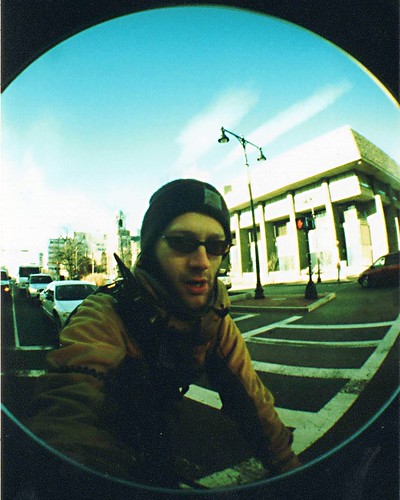After a bit of research into the matter last night (really, early this morning), I found that kernest.com offers many free fonts available for web use. And one of them is a version of my personal favorite for text, Goudy Old Style. It's not as nice as some versions out there, noticeably lacking the graceful curve along the base of the capital E and L, and the well-defined diamond shape of the dot on the i and j, as well as the separate Goudy Old Style Bold.
But it's quite nice for free, and does include Goudy Old Style Italic, not just an oblique version of the regular. I'm thinking of finding something different to use for the headlines, but that'll be a bit later. Anyways, I've put a colophon over at the right as a permanent note on such matters, for those who might also be typography geeks like me.
Monday, January 18, 2010
Must Read Article on the US Torture Program at Guantanamo
Scott Horton over at Harper's Magazine, which I highly recommend in general, has been following the story of our country's torture of terror suspects (perhaps, given the flimsy evidence often required, I should render that with scare quotes: “suspects”) for quite some time. You can look through his blog at Harper's online for several previous stories on the matter, as well as various other interesting stuff. As far as I can tell, he's pretty much the only journalist seriously investigating just what the hell our country is doing when it comes to torture.
Forthcoming in the March issue of Harper's is a new article on one of the most deeply troubling incidents, even by the hideous standards of the US torture program. This is the article I'll be quoting from, unless otherwise noted. The story starts back in 2006, when Salah Ahmed Al-Salami, Mani Shaman Al-Utaybi, and Yasser Talal Al-Zahrani (these names are also rendered in other ways, due to differences between Arabic naming customs and our own; I'll try to be consistent) were “discovered” dead in their cells, shortly after midnight on June 10th. The official story goes something like this:
Even that much is only known because Seton Hall University Law School students and staff managed to piece together an account from “1,700 pages of documents so heavily redacted as to be nearly incomprehensible,” and that the NCIS refused to disclose initially. The Seton Hall report, in its own words, “examines the investigation, not to determine what happened that night, but rather to assess why an investigation into three deaths could have failed to address significant issues.” The report itself is one in a series of reports, “analyzing government data to illuminate the interrogations and intelligence practices of the United States” by Seton Hall, including a previous one on the three “suicides” in question.
The Seton Hall report sums up the obvious discrepancies in the NCIS account thus:
And they pretty much leave things there, their stated purpose only being to examine the government's own reports, and not to investigate what might have actually happened. To get to that part of the story, let's turn our attention back to Scott Horton and the Harper's article. He reports that “four members of the Military Intelligence unit assigned to guard Camp Delta, including a decorated non-commissioned Army officer who was on duty as sergeant of the guard the night of June 9–10, have furnished an account dramatically at odds with the NCIS report—a report for which they were neither interviewed nor approached.”
The account that emerges seems to fit better in stories from behind the Iron Curtain back in the time of the Cold War. The Guantanamo prisoners are held in a collection of smaller camps collectively referred to as Camp Delta. (This is a more detailed map than the one in the Harper's article, and the terminology seems to vary as to what's meant by Camp Delta. So some of this is inconsistent with the article, but not in the important details.) Camps I, II, and III are open-air cells, Camp IV is mostly like a POW camp, for compliant prisoners, Camps V and VI are permanent facilities modeled on Federal Prisons, and Camp Echo holds prisoners in solitary confinement and has cells for prisoners meeting with their lawyers. Outside Camp Delta is Camp Iguana, where prisoners now believed to be innocent are held, and Camp Platinum (a.k.a. Camp VII), whose existence was kept secret for two years, and whose location is still, as far as I can tell, secret, was for 15 “high-value” detainees.
The soldiers interviewed in the article (who were stationed at the base in 2006) talk of a secret detention area they referred to as “Camp No,” in reference to the fact that its existence was denied by everyone present. This may be what was later revealed to be Camp Platinum, I really can't tell. They also tell of a windowless van, that they called the “paddy wagon” that transported prisoners from Camp Delta to other locations, including trips in the direction of “Camp No,” and whose comings and goings were not logged like all other vehicles.
The four soldiers are Sergeant Joe Hickman, Specialist Tony Davila, Specialist Christopher Penvose, and Specialist David Carroll. Hickman was on duty as the sergeant of the guard for Camp America (the Navy guarded the cell blocks themselves, the Army guarded the general area), the sector of Guantanamo that housed Camp Delta, but not “Camp No.” His account of the night states that he saw the “Paddy Wagon” retrieve a prisoner from Camp I, leave Camp Delta, heading towards the exit from Camp America (Camp I is within Camp Delta which is within Camp America, just to clarify here). Twenty minutes later it returned to Camp I to repeat the procedure, and then twenty minutes after that it was back. Hickman was curious, and drove out to the exit from Camp America to see which way it was heading on the third trip. Sure enough, it was in the direction of “Camp No.”
All three prisoners were removed from Camp Delta by 8:00PM. The “Paddy Wagon” returned at about 11:30PM, according to Hickman. Instead of returning to Camp I, however, this time it backed up to the medical facility. At approximately 11:45, Penvose says that he was asked by an unidentified Navy NCO to relay a coded message to a senior petty officer in the Camp Delta chow hall. Thirty minutes later, according to both Hickman and Penvose, the whole area was awash with stadium lighting and much commotion was taking place. Hickman and Davilla both recall being told that three prisoners had been brought to the medical clinic after having died from having rags stuffed down their throats.
Neither Penvose, manning a guard tower near the medical clinic, nor Carroll, manning a guard tower near Camp I, recall seeing any prisoners brought from Camp I to the clinic. The official reports state that the dead bodies were not discovered in their cells until shortly after midnight, rigor mortis having already set in. The implausible tale the NCIS tells, according to the Seton Hall report, continues:
Despite the rigor mortis, and the fact that the bodies were cold and blue, the medics attempted to resuscitate the three prisoners as they arrived at the clinic. This was when they discovered that each had a rag stuffed deep in his throat. Mani Shaman Al-Utaybi was declared dead at 1:15AM, Salah Ahmed Al-Salami was declared dead at 1:16AM, both at the clinic. Yasser Talal Al-Zahrani was transported to the hospital and declared dead at 1:50AM. Rear Admiral Harry Harris came to the clinic shortly afterwards to praise the medical staff and guards, and to reassure them that there was nothing they could have done.
The following day, Admiral Harris told the press “I believe this was not an act of desperation, but rather an act of asymmetrical warfare waged against us.”
I'll leave off here for now. We can call this Part I, covering the events up through the deaths of the three prisoners. Part II, whenever I might get around to it, can deal with the cover-up. I was thinking of throwing a more provocative title up top, but I figure that when pretty much accusing the US military of torture and murder, it's best to build the case carefully, rather than sound like a conspiracy theorist. Hopefully, with the case now laid out by Scott Horton and published online, with four US Army soldiers having come forward, the mainstream press will start to actually dig for some answers.
Forthcoming in the March issue of Harper's is a new article on one of the most deeply troubling incidents, even by the hideous standards of the US torture program. This is the article I'll be quoting from, unless otherwise noted. The story starts back in 2006, when Salah Ahmed Al-Salami, Mani Shaman Al-Utaybi, and Yasser Talal Al-Zahrani (these names are also rendered in other ways, due to differences between Arabic naming customs and our own; I'll try to be consistent) were “discovered” dead in their cells, shortly after midnight on June 10th. The official story goes something like this:
According to the NCIS, each prisoner had fashioned a noose from torn sheets and T-shirts and tied it to the top of his cell’s eight-foot-high steel-mesh wall. Each prisoner was able somehow to bind his own hands, and, in at least one case, his own feet, then stuff more rags deep down into his own throat. We are then asked to believe that each prisoner, even as he was choking on those rags, climbed up on his washbasin, slipped his head through the noose, tightened it, and leapt from the washbasin to hang until he asphyxiated. The NCIS report also proposes that the three prisoners, who were held in non-adjoining cells, carried out each of these actions almost simultaneously.(The NCIS is the Naval Criminal Investigative Service, who have primary jurisdiction over investigating crimes at Guantanamo. Cynics may recognize a familiarity between their handiwork above and their “investigation” into the USS Iowa turret explosion in 1989.)
Even that much is only known because Seton Hall University Law School students and staff managed to piece together an account from “1,700 pages of documents so heavily redacted as to be nearly incomprehensible,” and that the NCIS refused to disclose initially. The Seton Hall report, in its own words, “examines the investigation, not to determine what happened that night, but rather to assess why an investigation into three deaths could have failed to address significant issues.” The report itself is one in a series of reports, “analyzing government data to illuminate the interrogations and intelligence practices of the United States” by Seton Hall, including a previous one on the three “suicides” in question.
The Seton Hall report sums up the obvious discrepancies in the NCIS account thus:
The original military press releases did not report that the detainees had been dead for more than two hours when they were discovered, nor that rigor mortis had set in by the time of discovery.
There is no explanation of how three bodies could have hung in cells for at least two hours while the cells were under constant supervision, both by video camera and by guards continually walking the corridors guarding only 28 detainees.
There is no explanation of how each of the detainees, much less all three, could have done the following: braided a noose by tearing up his sheets and/or clothing, made a mannequin of himself so it would appear to the guards he was asleep in his cell, hung sheets to block vision into the cell—a violation of Standard Operating Procedures, tied his feet together, tied his hands together, hung the noose from the metal mesh of ii the cell wall and/or ceiling, climbed up on to the sink, put the noose around his neck and released his weight to result in death by strangulation, hanged until dead and hung for at least two hours completely unnoticed by guards.
There is no indication that the medics observed anything unusual on the cell block at the time that the detainees were hanging dead in their cells.
The initial military press releases did not report that, when the detainees‘ bodies arrived at the clinic, it was determined that each had a rag obstructing his throat.
There is no explanation of how the supposed acts of “asymmetrical warfare” could have been coordinated by the three detainees, who had been on the same cell block fewer than 72 hours with occupied and unoccupied cells between them and under constant supervision.
There is no explanation of why the Alpha Block guards were advised that they were suspected of making false statements or failing to obey direct orders.
There is no explanation of why the guards were ordered not to provide sworn statements about what happened that night.
There is no explanation of why the government seemed to be unable to determine which guards were on duty that night in Alpha Block.
There is no explanation of why the guards who brought the bodies to the medics did not tell the medics what had happened to cause the deaths and why the medics never asked how the deaths had occurred.
There is no explanation of why no one was disciplined for acts or failures to act that night.
There is no explanation of why the guards on duty in the cell block were not systematically interviewed about the events of the night; why the medics who visited the cell block before the hangings were not interviewed; or why the tower guards, who had the responsibility and ability to observe all activity in the camp, were not interviewed.
And they pretty much leave things there, their stated purpose only being to examine the government's own reports, and not to investigate what might have actually happened. To get to that part of the story, let's turn our attention back to Scott Horton and the Harper's article. He reports that “four members of the Military Intelligence unit assigned to guard Camp Delta, including a decorated non-commissioned Army officer who was on duty as sergeant of the guard the night of June 9–10, have furnished an account dramatically at odds with the NCIS report—a report for which they were neither interviewed nor approached.”
The account that emerges seems to fit better in stories from behind the Iron Curtain back in the time of the Cold War. The Guantanamo prisoners are held in a collection of smaller camps collectively referred to as Camp Delta. (This is a more detailed map than the one in the Harper's article, and the terminology seems to vary as to what's meant by Camp Delta. So some of this is inconsistent with the article, but not in the important details.) Camps I, II, and III are open-air cells, Camp IV is mostly like a POW camp, for compliant prisoners, Camps V and VI are permanent facilities modeled on Federal Prisons, and Camp Echo holds prisoners in solitary confinement and has cells for prisoners meeting with their lawyers. Outside Camp Delta is Camp Iguana, where prisoners now believed to be innocent are held, and Camp Platinum (a.k.a. Camp VII), whose existence was kept secret for two years, and whose location is still, as far as I can tell, secret, was for 15 “high-value” detainees.
The soldiers interviewed in the article (who were stationed at the base in 2006) talk of a secret detention area they referred to as “Camp No,” in reference to the fact that its existence was denied by everyone present. This may be what was later revealed to be Camp Platinum, I really can't tell. They also tell of a windowless van, that they called the “paddy wagon” that transported prisoners from Camp Delta to other locations, including trips in the direction of “Camp No,” and whose comings and goings were not logged like all other vehicles.
The four soldiers are Sergeant Joe Hickman, Specialist Tony Davila, Specialist Christopher Penvose, and Specialist David Carroll. Hickman was on duty as the sergeant of the guard for Camp America (the Navy guarded the cell blocks themselves, the Army guarded the general area), the sector of Guantanamo that housed Camp Delta, but not “Camp No.” His account of the night states that he saw the “Paddy Wagon” retrieve a prisoner from Camp I, leave Camp Delta, heading towards the exit from Camp America (Camp I is within Camp Delta which is within Camp America, just to clarify here). Twenty minutes later it returned to Camp I to repeat the procedure, and then twenty minutes after that it was back. Hickman was curious, and drove out to the exit from Camp America to see which way it was heading on the third trip. Sure enough, it was in the direction of “Camp No.”
All three prisoners were removed from Camp Delta by 8:00PM. The “Paddy Wagon” returned at about 11:30PM, according to Hickman. Instead of returning to Camp I, however, this time it backed up to the medical facility. At approximately 11:45, Penvose says that he was asked by an unidentified Navy NCO to relay a coded message to a senior petty officer in the Camp Delta chow hall. Thirty minutes later, according to both Hickman and Penvose, the whole area was awash with stadium lighting and much commotion was taking place. Hickman and Davilla both recall being told that three prisoners had been brought to the medical clinic after having died from having rags stuffed down their throats.
Neither Penvose, manning a guard tower near the medical clinic, nor Carroll, manning a guard tower near Camp I, recall seeing any prisoners brought from Camp I to the clinic. The official reports state that the dead bodies were not discovered in their cells until shortly after midnight, rigor mortis having already set in. The implausible tale the NCIS tells, according to the Seton Hall report, continues:
Al Zahrani was reportedly discovered hanging in his cell after midnight on June 10. Upon discovery, the Alpha guards did not call the medics to assist, nor did they advise the medical clinic or call for escort guards or any kind of assistance, as required by SOPs. Instead, all five Alpha guards transported Al Zahrani to the medical clinic approximately 100 yards away. According to the autopsy reports, it took about 28 minutes to do so, leaving the cell block completely unguarded while two other detainees hung in their cells. The Alpha guards did not notice two other detainees hanging dead in their cells.
Despite the rigor mortis, and the fact that the bodies were cold and blue, the medics attempted to resuscitate the three prisoners as they arrived at the clinic. This was when they discovered that each had a rag stuffed deep in his throat. Mani Shaman Al-Utaybi was declared dead at 1:15AM, Salah Ahmed Al-Salami was declared dead at 1:16AM, both at the clinic. Yasser Talal Al-Zahrani was transported to the hospital and declared dead at 1:50AM. Rear Admiral Harry Harris came to the clinic shortly afterwards to praise the medical staff and guards, and to reassure them that there was nothing they could have done.
The following day, Admiral Harris told the press “I believe this was not an act of desperation, but rather an act of asymmetrical warfare waged against us.”
I'll leave off here for now. We can call this Part I, covering the events up through the deaths of the three prisoners. Part II, whenever I might get around to it, can deal with the cover-up. I was thinking of throwing a more provocative title up top, but I figure that when pretty much accusing the US military of torture and murder, it's best to build the case carefully, rather than sound like a conspiracy theorist. Hopefully, with the case now laid out by Scott Horton and published online, with four US Army soldiers having come forward, the mainstream press will start to actually dig for some answers.
Sunday, January 10, 2010
More of the Fisheye Pictures
The week after Christmas is usually not that busy at work, so I grabbed the Fisheye camera to finish off the roll of film. That last self-portrait was one of them, here's some others now that I've scanned them in. All with the Fisheye2 Lomo camera, Fuji Sensia 400, cross-processed, and scanned in with my crappy scanner:

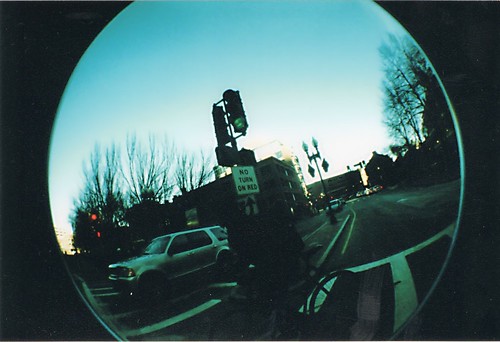

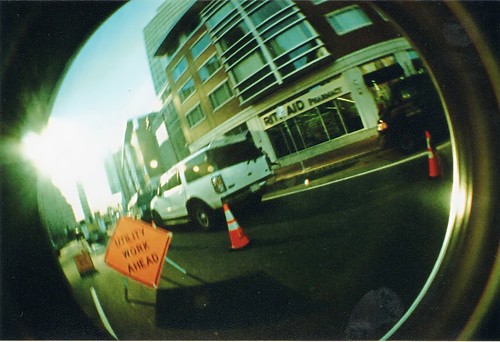

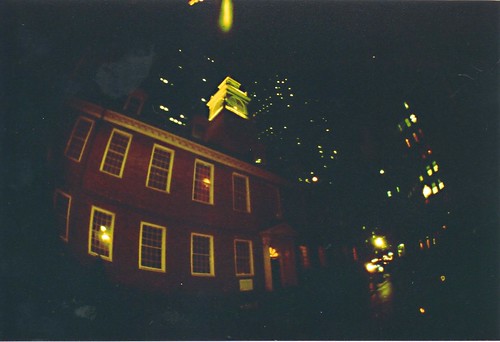

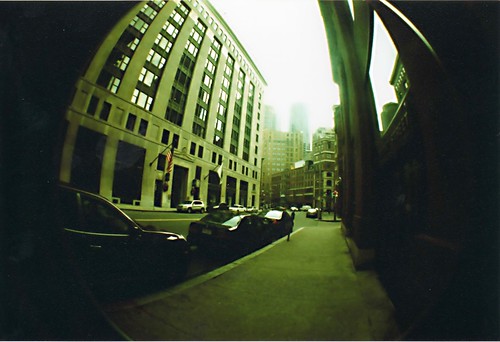












Labels:
photography
Saturday, January 2, 2010
It's Been a While
OK, I'm going to try to get this back up and running for 2010. To start, here's my latest self-portrait. This was my first attempt at getting slide film cross-processed, and with the Fisheye2 Lomo camera, there's no way to control exposure, so it was an interesting experience. There's definitely something great about having no clue how anything's going to look until after you've paid good money to get it processed. Some of the shots were just way too dark, but a bunch were pretty cool. My scanner's pretty shitty, but I'll try to get the rest of the cool ones up soon. Maybe I can stretch it into a couple weeks of blog posts.
Labels:
photography
Subscribe to:
Posts (Atom)
